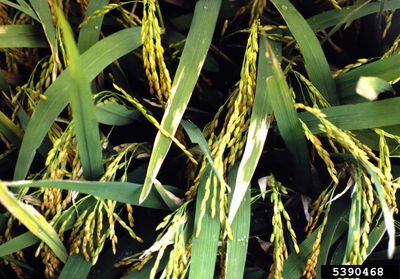What is Rice Bacterial Leaf Blight?
Bacterial leaf blight in rice is a destructive bacterial disease that was first observed in 1884-1885 in Japan. It is caused by the bacterium Xanthomonas oryzae pv. oryzae. It is present in rice cropping regions of Asia, Africa, Australia, Latin America and the Caribbean and very rarely in the United States (Texas).
Symptoms of Rice with Bacterial Leaf Blight
The first signs of rice with bacterial leaf blight are water-soaked lesions at the edges and towards the tip of leaf blades. These lesions grow larger and release a milky sap that dries and turns a yellowish color. This is followed by characteristic, grayish-white lesions on the leaves. This last stage of infection precedes the drying out and death of the foliage. In seedlings, infected leaves turn grayish-green and roll up. As the disease progresses, leaves turn yellow and wilt. Within 2-3 weeks, infected seedlings will dry up and die. Adult plants may survive but with reduced yields and quality.
Rice Bacterial Leaf Blight Control
The bacterium thrives in warm, humid environments and is fostered by high rainfall combined with wind, wherein it enters the leaf through injured tissues. Further, it travels through the flooded waters of the rice crop to the roots and leaves of neighboring plants. Crops heavily fertilized with nitrogen are the most susceptible. The least expensive and most effective method of control is to plant resistant cultivars. Otherwise, limit and balance the amount of nitrogen fertilizer, ensure good drainage in the field, practice good sanitation by removing weeds and plowing under stubble and other rice detritus, and allow fields to dry between plantings.
